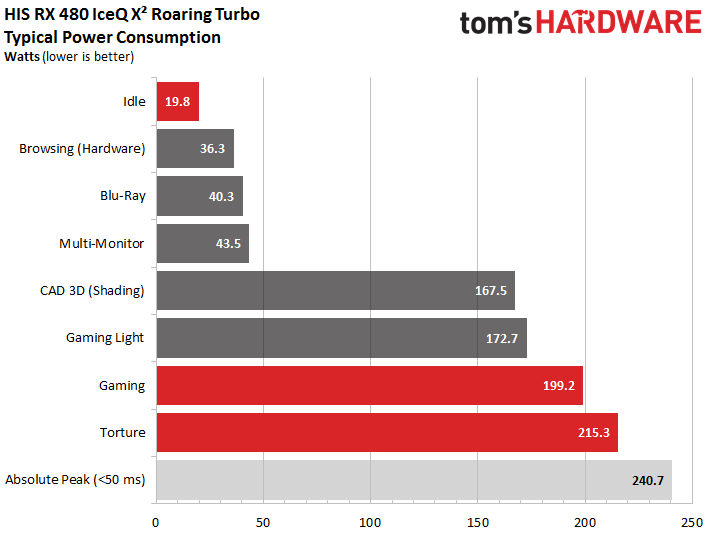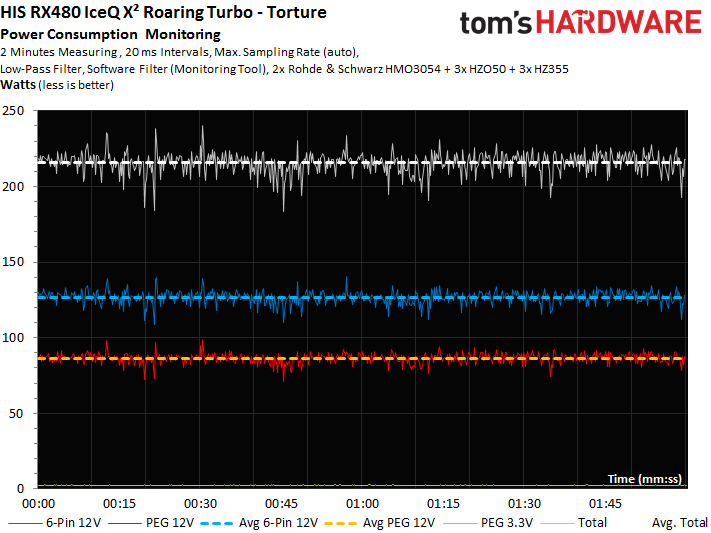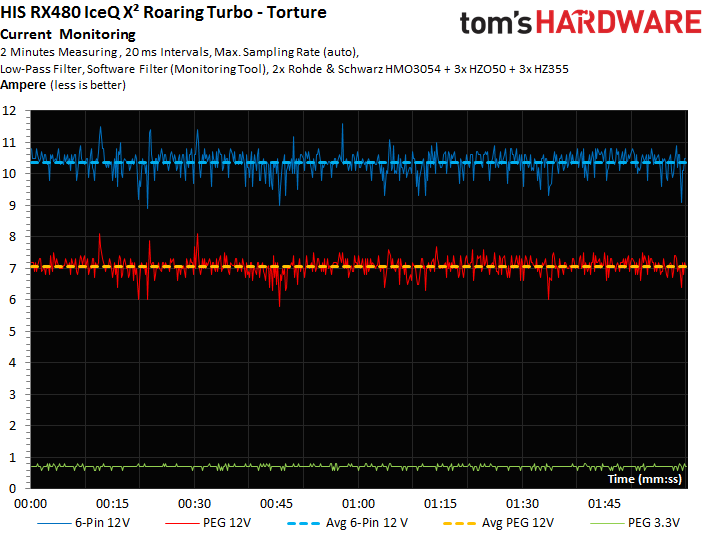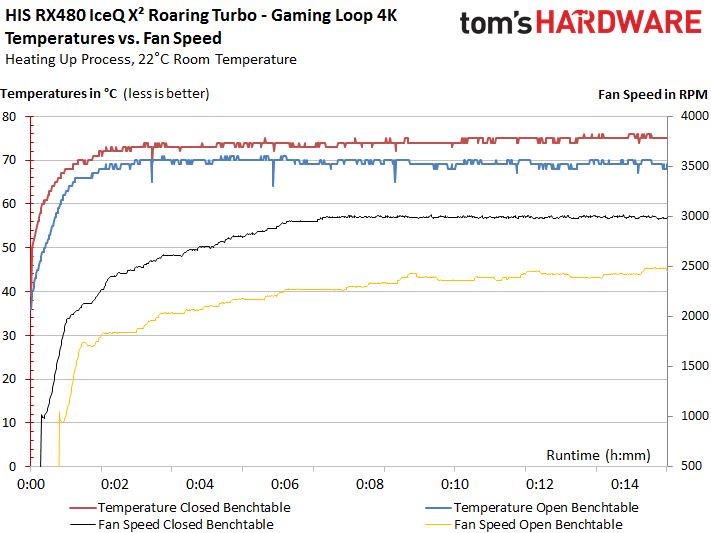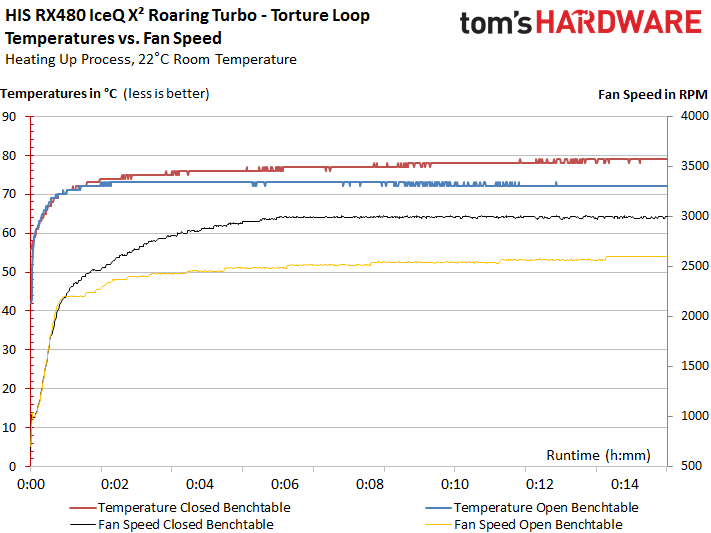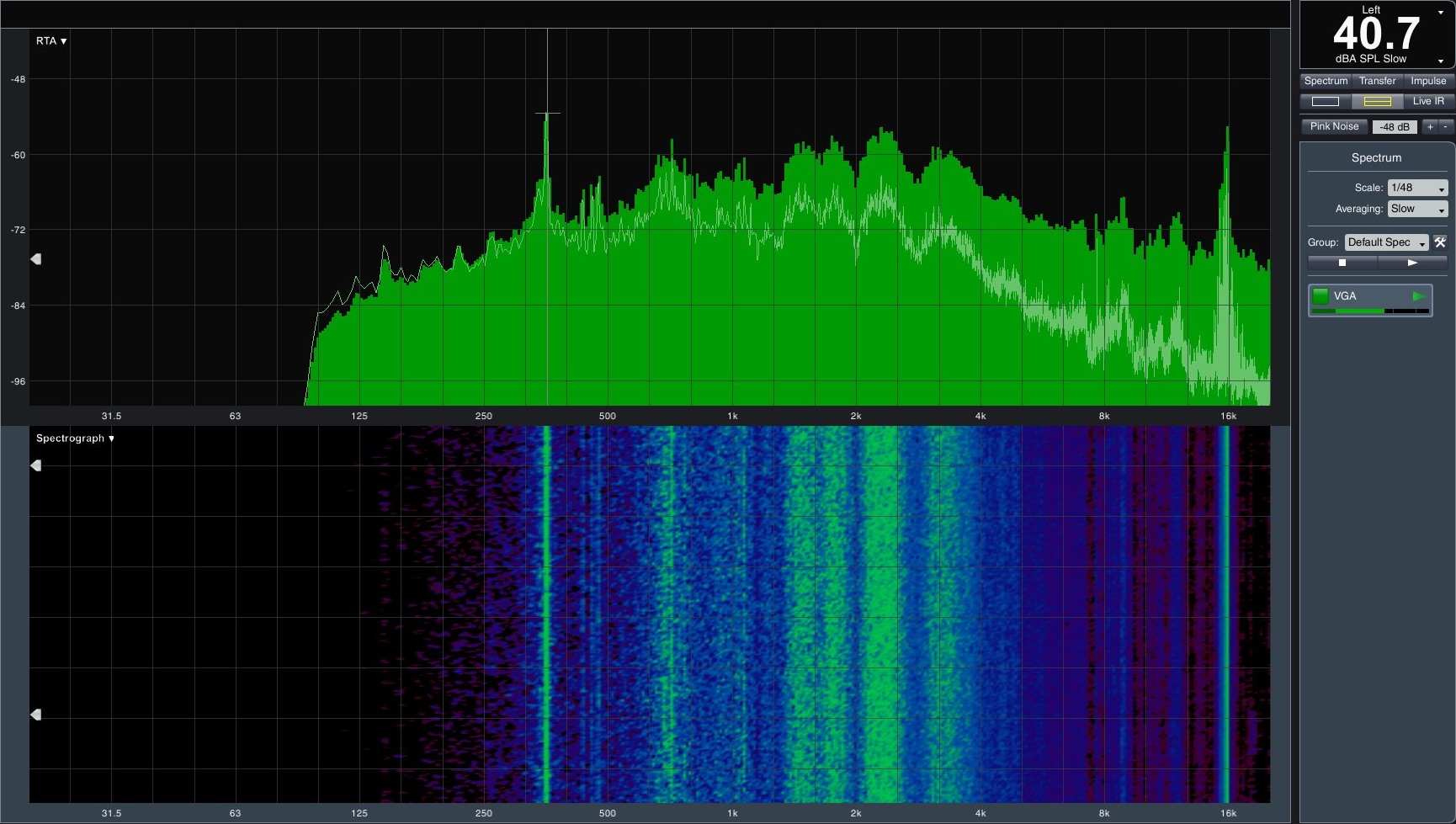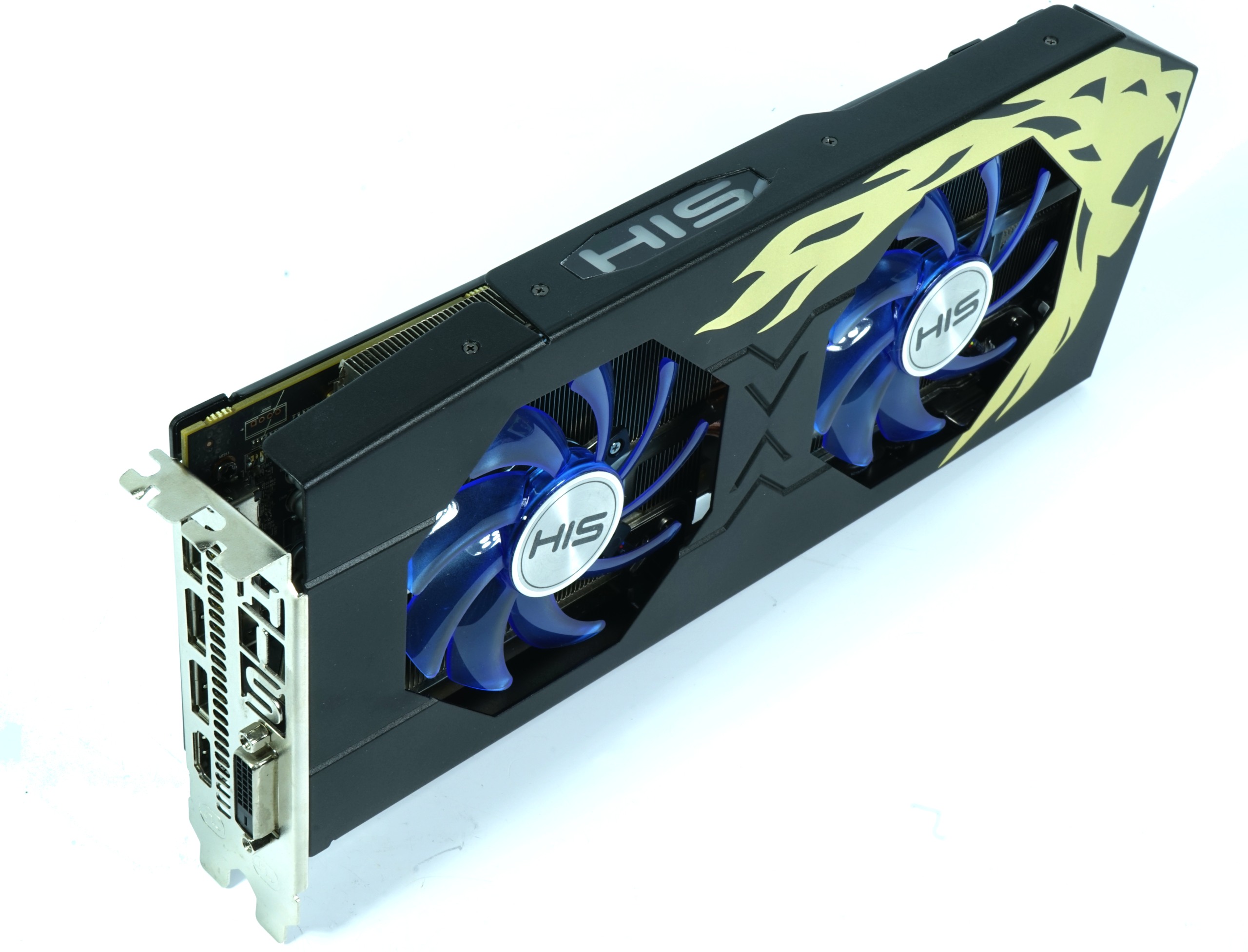AMD Radeon RX 480 Graphics Card Roundup
HIS RX 480 IceQ X² Roaring Turbo
Why you can trust Tom's Hardware
With its Roaring Turbo implementation, HIS pushes GPU clock rates up to 1338 MHz, giving the two fans a challenging task in the process. So, does Roaring refer to this card's performance, noise, or both? We're interested to see if that frequency can be maintained under our taxing workloads.
HIS is now a subsidiary of Pine, just like XFX. So, during the course of our analysis, we'll have plenty of opportunities to draw parallels to the XFX equivalent of this card. That's good news, since the RX 480 IceQ X² Roaring Turbo isn't readily available to our U.S.-based readers. The two boards aren't exact clones of each other, though. HIS does take some liberties that we'll explore in depth.
Specifications
MORE: Best Graphics Cards
MORE: Desktop GPU Performance Hierarchy Table
MORE: All Graphics Content
Exterior & Interfaces
Weighing 32 ounces (906 grams), the RX 480 IceQ X² Roaring Turbo is no lightweight. It still fits within a dual-slot form factor though, measuring 28.9cm long, 13.5cm tall, and 3.5cm wide. Because of the backplate, you must plan for an additional one-fifth of an inch (5mm) of clearance to avoid collisions with your CPU's cooler, complicating installations in compact cases.


The fan shroud is made of light metal and does exude higher quality than some of the plastic-covered competition, even if it makes the card unnecessarily tall. It could have been 2cm shorter, improving its compatibility with a greater number of cases. A gold-colored decal forms the shape of a stylized roaring lion.
In contrast to older HIS cards, this one's fins are oriented vertically, unfortunately. Not only does this prevent heat from escaping from the slot bracket, but it also causes the motherboard to warm up. The top of the card is dominated by an illuminated HIS logo and eight-pin auxiliary power connector.


Around back, you get a peek at three of the four 6mm heat pipes. Meanwhile, the slot bracket exposes a familiar complement of outputs. Next to a cut-out styled to spell HIS, there's a DVI-I connector, three DisplayPort 1.4-ready interfaces, and one full-sized HDMI 2.0 port. Small vents run down the center, though they serve no practical purpose.
Board & Components
HIS puts the Ellesmere GPU on the board's left side, sticking with AMD's reference layout. As a result, the PCB's right side is sparsely populated with voltage regulation circuitry and a few other components. The company probably could have come up with a shorter design.
Like AMD, HIS uses eight Samsung GDDR5 memory modules (model number K4G80325FB-HC25). Each one has a capacity of 8Gb (32x 256Mb). And depending on clock rate, they can operate at voltages between 1.305V and 1.597V. Their ceiling is 2000 MHz, similar to what we find on Nvidia's GeForce GTX 1070.
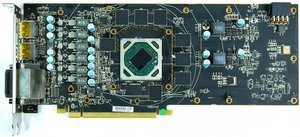
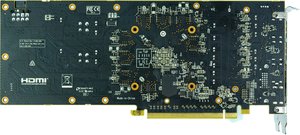
The GPU is fed by six power phases using International Rectifier's IR3567B dual-output 6+2-phase controller. In turn, an IR CHL8510 high-performance gate driver controls the high- and low-side N-channel MOSFETs.

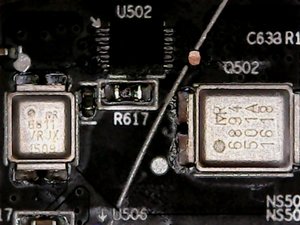
The actual voltage conversion is handled by an IRF6811 on the high side and an IRF6894 on the low side. The advantage of Infineon's DirectFET packaging is that it's easier to cool. However, the housing isn't isolated, so you need to keep an eye out for anything that might cause a short circuit.

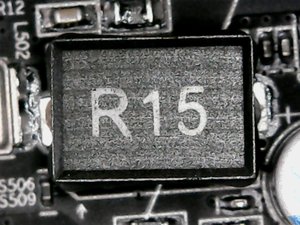
HIS employs encapsulated ferrite coils covered by a thin-walled housing. Their quality is about average, as vibrations are both measurable and audible as a subtle buzzing noise.
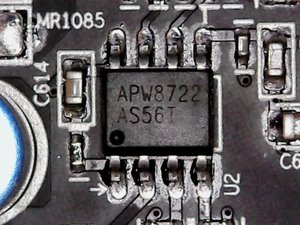
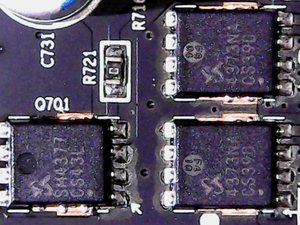
The RX 480 IceQ X² Roaring Turbo relies on one phase to power its memory, located on the board's right side. A second, seemingly similar voltage converter provides power for peripherals and controllers. An Anpec APW8722 synchronous buck converter controls a Sinopower SM4377 on the high side and two SM4373s on the low side.
Power Results
This factory-overclocked card's power consumption is significantly higher than what we measured from the reference design. Its almost 20W at idle doesn't impress us, and we can see it's caused by rather generous voltage settings and a high frequency of 300 MHz.
During our gaming loop, the RX 480 IceQ X² Roaring Turbo consumes almost 200W, which is 30W higher than AMD's own solution. Meanwhile, our stress test pushed HIS' board as high as 215W.
We mention short load peaks only as a side note (see the light-grey bar in the chart below), since they're rarely relevant in practice. Nevertheless, they illustrate the importance of deploying a reasonably-sized secondary side for the power supply (low-impedance caps).
The following two graphs represent two minutes captured from the gaming loop and stress test. These are what our average power consumption figures are calculated from.
The next two graphs map current measurements at each of the supply rails, corresponding to the power consumption levels shown in the diagrams above.
Well, this isn't good. If you remember back to our Radeon RX 480 launch review, it was an out-of-spec load on the motherboard slot's +12V rail that forced AMD to add a compatibility mode to its driver. The values we measure for HIS' RX 480 IceQ X² Roaring Turbo are even worse, though!
A measurement of 7A exceeds the PCI-SIG spec's maximum of 5.5A by almost 30%! Even if modern boards can fall back on a fourth pin (meant as a reserve) to better distribute current, we definitely can't recommend this card to anyone looking to upgrade an older platform.
Temperature Results
HIS' cooler is both simple and conservative. It employs a backplate that is isolated with foil on the inside and does nothing to cool the board. Instead, the plate helps with stabilization and looks good.
The memory modules are not cooled by the heat sink, but rather by a small frame below it. You'd better believe we plan to quantify how well (or not) this concept works.
The cooler consists of a copper slug over the GPU and a total of four 6mm heat pipes pressed into it. Those pipes are made of a sintered composite material, and as you can see they aren't nickel-plated. A plate on the back connects the sink to one part of the finned structure. It's supported by the heat pipe that's bent back. Meanwhile, the other three pipes transport thermal energy the other direction, into another array of aluminum fins.
A peak clock rate of 1388 MHz during our gaming loop, which only drops by a few megahertz every once in a while, is indicative of the cooler's excellent performance. We blame the dips on a power limit that rears its head when we apply particularly taxing workloads.
Registering close to 152°F (67°C) on our open test bench and almost 158°F (70°C) in a closed case, the VRMs are even cooler than the GPU, which heats up to 158°F (70°C) and 163°F (73°C), respectively. The memory isn't particularly hot either, so we can confidently say that HIS does a fine job with cooling.

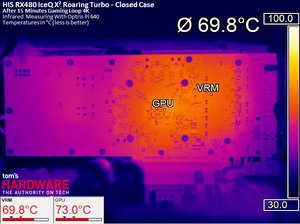
During the stress test, we measured 162°F (72°C) and 165°F (74°C) for the voltage converters. The processor is still fine as well, yielding a 163°F (73°C) result on our open test bench. Inside of a closed case, the PCB under the GPU's package reaches 169°F (76°C).
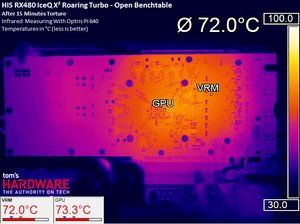

Again, this card's cooling is completely ample, even in a closed case.
Sound Results
The rotor geometry and blade count on the two 92mm fans are designed to provide high static pressure through the heat sink's dense array of fins. Thus, the fan speeds need to spin quickly in order to achieve the temperatures we measured.
A reading of roughly 3000 RPM in a closed case is high indeed (roughly 2500 RPM on an open test bench is up there, too). This naturally has an impact on the sound pressure level. During gaming, the almost 41 dB(A) we observed isn't particularly loud, but it's definitely audible. After all, the RX 480 IceQ X² Roaring Turbo has to dissipate about 200W of waste heat.
Low-frequency bearing noise at ~350 Hz dominates the spectrum chart, along with the fan itself between 2.5 and 4.5 kHz. We were also able to measure higher-frequency noises at approximately 16 KHz, corresponding to the voltage converters. Human ears are going to have a hard time hearing that, though.
HIS' RX 480 IceQ X² Roaring Turbo isn't a bad implementation of the Radeon RX 480. It does, however, suffer from an inappropriate distribution of power phases. This leads to current flow through the motherboard's PCIe slot that's almost 30% higher than the PCI-SIG's maximum specification.
This problem was exposed right when AMD launched the RX 480, so it's surprising that HIS not only ignores the issue but actually makes it worse, trampling upon specifications in the process.
The cooling performance we observed is quite convincing, and the fan noise is tolerable. An aggressive clock rate that's almost completely stable would have made this board worthy of recommendation if it wasn't for the overload condition.
Thus, the way it sits currently, we cannot recommend the RX 480 IceQ X² Roaring Turbo. Instead, we have to suggest making sure your motherboard uses four pins, rather than the three standardized ones, for the card's power supply. If you don't know or can't tell, it's probably better to look for an alternative.
HIS RX 480 IceQ X² Roaring Turbo
Reasons to buy
Reasons to avoid

MORE: Nvidia GeForce GTX 1080 Roundup
MORE: Nvidia GeForce GTX 1070 Roundup
MORE: Nvidia GeForce GTX 1060 Roundup
Current page: HIS RX 480 IceQ X² Roaring Turbo
Prev Page Asus ROG Strix RX 480 Next Page MSI RX 480 Gaming X 8GGet Tom's Hardware's best news and in-depth reviews, straight to your inbox.

Igor Wallossek wrote a wide variety of hardware articles for Tom's Hardware, with a strong focus on technical analysis and in-depth reviews. His contributions have spanned a broad spectrum of PC components, including GPUs, CPUs, workstations, and PC builds. His insightful articles provide readers with detailed knowledge to make informed decisions in the ever-evolving tech landscape
-
alchemy69 Not sure where you found a reference card for $180 but it sure as Hell wasn't Amazon.Reply -
artk2219 You can find them on Newegg for around that much pretty often. Also the R9 Fury is a hell of a mixed bag, Some games its matching a 1070, others its below the 480. Weird.Reply -
techy1966 I only ask because I have 2 390x cards and I get way better results than yours does here and yes with crossfire off mine is getting better results granted it is overclocked @1236mhz. Heck I just played watch dog 2 single card mode and got always above 60 fps here that card is getting 45 fps..just saying is all. Nice write up though. Just noticed GTA numbers as well and was WTH why is their 390x card sucking so much must be old old drivers I 'm sorry but even with crossfire off my numbers at 1080p are way higher maxed out. I do know I can beat a 480 in everything and slaughter it in crossfire will Vega ever get here already or do I have to slide over to the green team lol.Reply -
shrapnel_indie HIS has been missing from the U.S. Market for a few years now. As to noise, Yes we can measure it, and determine a loudness level, but tolerance is dependent on the individual as always. I still question the price links used as some are unrealistically high compared to the market Amazon competes in (Mail-Order.)Reply
Was the latest driver used? Was the BIOS updated in every card? -
digitalgriffin I am a bit perplexed as to why you love the ASUS Strix so much with a 6 pin power connector. Either it's pulling too much power over the PEG, or pulling too much power over the 6 pin. It really needs an 8 pin connector to stay in spec.Reply -
blppt "Also the R9 Fury is a hell of a mixed bag, Some games its matching a 1070, others its below the 480. Weird."Reply
The newest generation AMD cards (Polaris) are apparently designed to handle heavy Tessellation better than previous gens, so my guess is that would be the circumstances in which the RX480 beats the Fury. I would say it was the extra 4GB of frame buffer space, but we've seen that the HBM often negates that RAM shortage in many benchmarks. -
NewbieGeek Hmm. Interesting article. Personally never had temperature issues with my Sapphire Nitro rx 480 8gb. Maybe Tom's is defective? Mine runs at 1330mhz core 2020mhz ram without drops, even during intense gaming... And I've got a custom fan curve making the card quieter than stock...Reply



